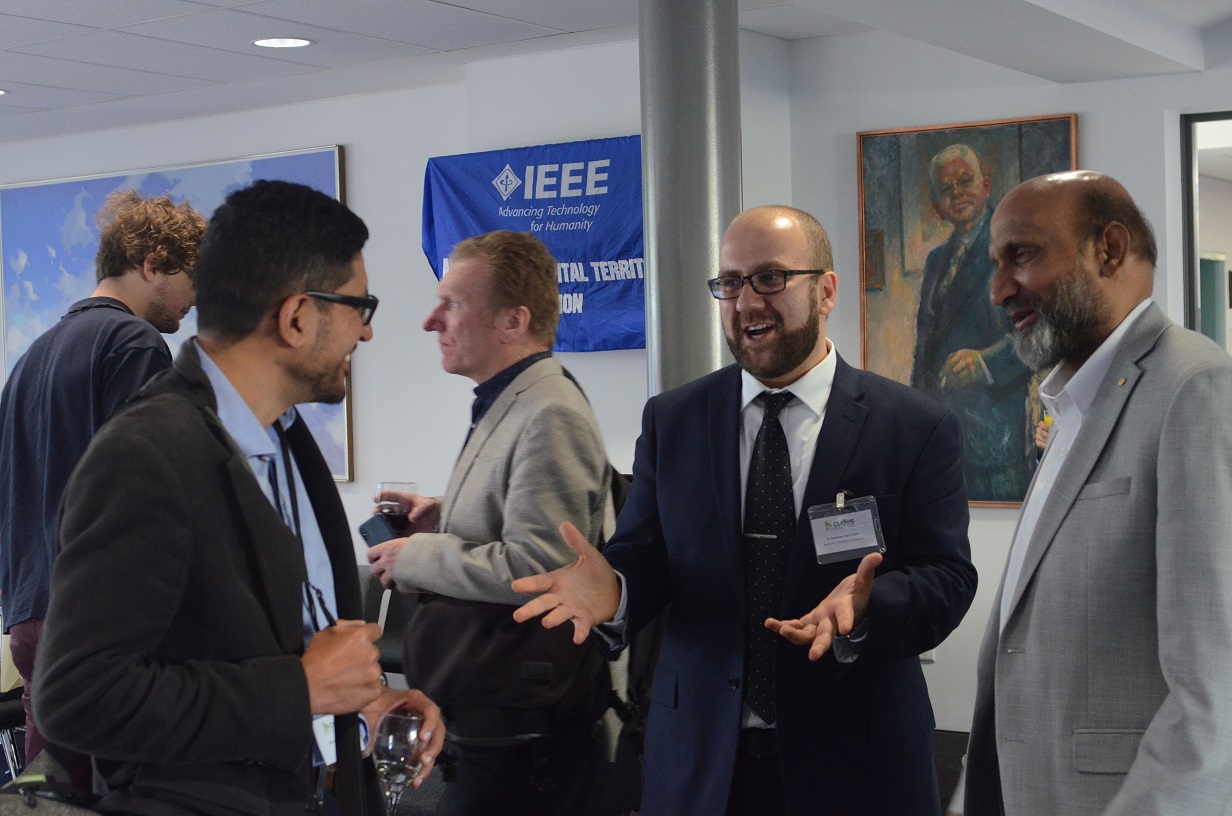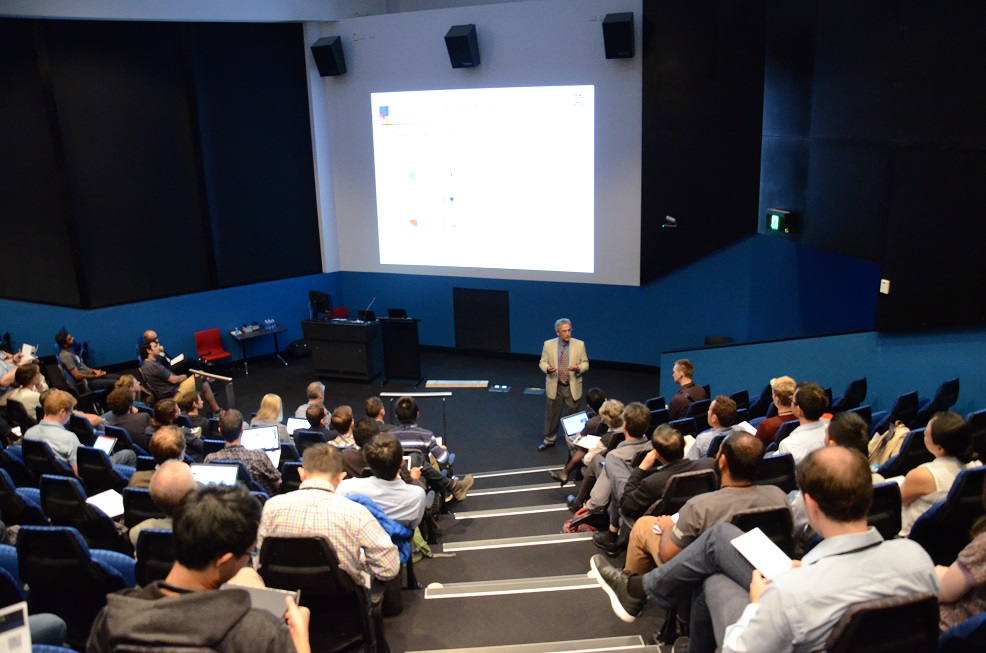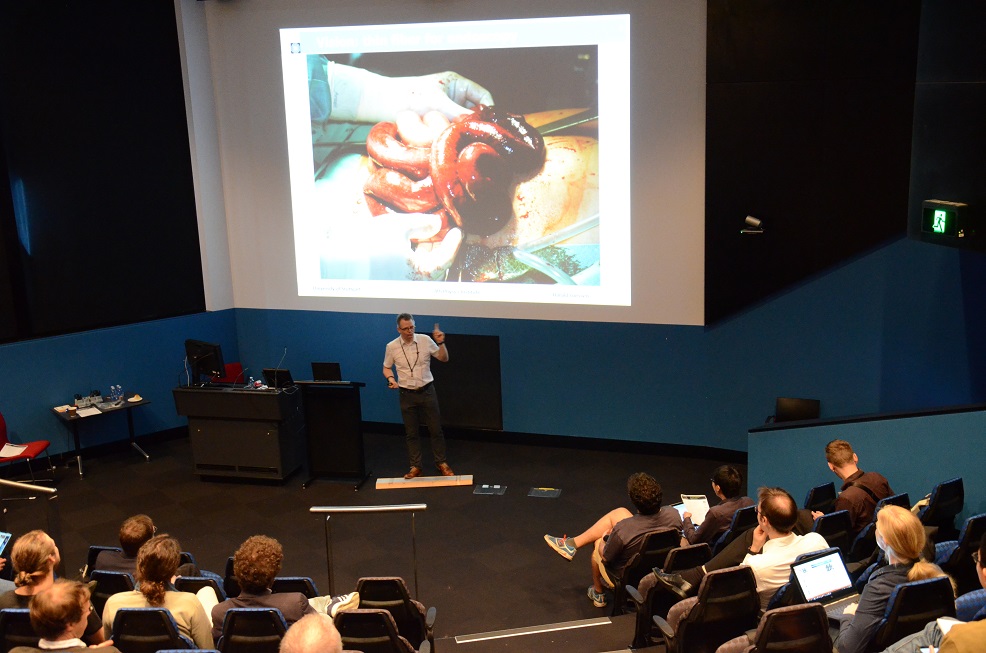Nanophotonics 2018 - The next Frontier

Nanophotonics 2018 - The next Frontier was held in early March 2018. This workshop was focused on the optical processes in nano-structures and -systems. The meeting scope covered both fundamental and applied photonics with topics including metamaterials, plasmonics, 2D materials, nano and microscale photonic waveguides, novel nonlinear materials and nonlinear quantum optics.
Date and Time
Location
Hosts
Registration
-
 Add Event to Calendar
Add Event to Calendar
- Finkel Lecture Theatre and JCSMR Foyer
- Australian National University
- Canberra, Australian Capital Territory
- Australia 2601
- Building: John Curtin School of Medical Research
- Room Number: Finkel Lecture Theatre
- Contact Event Host
- Co-sponsored by Mohsen Rahmani
- Survey: Fill out the survey
Speakers
 Prof. Nader Engheta of University of Pennsylvania, USA
Prof. Nader Engheta of University of Pennsylvania, USA
Can we do math and solve equations with metamaterials?
Metastructures have provided a fascinating platform for unprecedented light-matter interaction with a wide variety of potential applications. Numerous exciting features and phenomena enabled by wave dynamics in metastructures have been introduced and developed in recent years. One such feature is the possibility of performing mathematical operations and signal processing with metamaterials [A. Silva, F. Monticone, G. Castaldi, V. Galdi, A. Alu, and N. Engheta, “Performing mathematical operations with metamaterials,” Science, 343, 160-163 (2014); A. Vakil and N. Engheta, “Fourier optics on graphene,” Phys. Rev. B 85, 075434 (2012)]. By properly juxtaposing metastructures with different material properties, we can design “circuits with light at the nanoscale” and we can conceive of platforms that can perform mathematical operations and solve equations. In other words, materials can act as “circuits” and materials can do math. In my group we have been developing this concept, and currently we are conducting research on metamaterial platforms that can solve the Fredholm integral equations of the 2nd kind. We are considering two different categories of structures, i.e., inhomogeneous platforms and Mach-Zehnder interferometer (MZI) meshes. In this talk, I will present some of the latest results of our onging work on metamaterial-based analog computing and information processing.
Biography:
Nader Engheta is the H. Nedwill Ramsey Professor at the University of Pennsylvania. He received his PhD from Caltech. His current research activities span various areas of nanophotonics, metamaterials, nano-optics, electrodynamics, graphene optics, optical circuits, imaging and sensing inspired by eyes of animal species, and physics and engineering of light-matter interaction. His most recent awards include William Streifer Scientific Achievement Award, SPIE Gold Medal, Fellow of US National Academy of Inventors, Vannevar Bush Faculty Fellow Award, IEEE Electromagnetics Award, and URSI Balthasar van der Pol Gold Medal. He is a Fellow of OSA, APS, MRS, SPIE, IEEE, URSI, and AAAS.
 Prof. Harald Giessen of Stuttgart University, Germany
Prof. Harald Giessen of Stuttgart University, Germany
Merging micro- and nano-optics: Fundamental aspects and applications
Plasmonic nanostructures enable extreme subwavelength concentration of light. This has led to many exciting new avenues in linear and nonlinear optics as well as in sensing.
Highly nonlinear optical processes can lead to electron emission from atomically flat plasmonic surfaces. This reveals the subfemtosecond dynamics of plasmon focusing to 60 nm and subsequent vortex formation. Higher orbital angular momenta can be confined to below 100 nm, possibly suited for nondipolar interaction with large individual quantum systems (see left picture).
On the micro-scale, femtosecond 3D printing opens a new avenue in micro-optics. Arbitrary freeform and aspheric shapes can realize high-quality and even diffraction-limited imaging systems as well as multi-element microscope objectives for endoscopes and sensors with sizes of only a few hundred micrometers (see middle and right picture). When combined with active nano-optical elements, beam shifting, scanning as well as zooming can be realized without any moving parts.
Combining micro- and nano-optics will serve as enabling technology for understanding fundamental material science questions as well as realizing optical, chemical, biological and medical applications in the future.
Biography:
Harald Giessen is full professor and holds the Chair for Ultrafast Nanooptics in the Department of Physics at the University of Stuttgart. He is also co-chair of the Stuttgart Center of Photonics Engineering, SCoPE. He was guest researcher at the University of Cambridge, and guest professor at the University of Sydney, at A*Star, Singapore. He is associated researcher at the Center for Disruptive Photonic Technologies at Nanyang Technical University, Singapore. He received an ERC Advanced Grant in 2012 for his work on complex nanoplasmonics. His research interests include Ultrafast Nano-Optics, Plasmonics, Metamaterials, 3D Printed Micro- and Nano-Optics, Novel mid-IR Ultrafast Laser Sources, Applications in Microscopy, Biology, and Sensing.
Agenda
Tuesday, 6 March 2018
| 08:15 - 09:00 | Arrival and Registration |
| 09:00 | Session 1 - Chair: Mohsen Rahmani (Australian National University) |
| 09:00 - 09:15 | Mohsen Rahmani: Opening |
| 09:15 - 09:45 | Benjamin Eggleton: Welcome and Introduction by CUDOS Director |
| 09:45 - 10:25 | Nader Engheta: Can we do math and solve equations with metamaterials? |
| 10:25 - 10:40 | Birgit Stiller: Photonic-phononic memory: tailoring stimulated Brillouin scattering for light storage |
| 10:40 - 11:00 | Morning Tea |
| 11:00 | Session 2 - Chair: Alexander Solntsev (University of Technology, Sydney) |
| 11:00 - 11:25 | Yuri Kivshar: All-Dielectric Resonant Meta-Optics |
| 11:25 - 12:05 | Igal Brener: Recent Advances in Linear and Nonlinear All-Dielectric Metamaterials |
| 12:05 - 12:30 | Ann Roberts: Sensing Light with Plasmonics |
| 12:30 - 13:30 | Lunch |
| 13:30 | Session 3 - Chair: Birgit Stiller (The University of Sydney) |
| 13:30 - 13:55 | Min Gu: Optical Beam Nanolithography under Two-Photon Excitation |
| 13:55 - 14:20 | Simon Fleming: Metamaterials Fabricated by Fibre Drawing |
| 14:20 - 14:35 | Arnan Mitchell: Integrated Photonic and Microfluidic Systems for Point of Care Biosensor Applications |
| 14:35 - 14:50 | David Lancaster: A chip-based dual frequency-comb sensor |
| 14:50 - 15:05 | Robert McLaughlin: Imaging Needles: bringing optics deep inside the body |
| 15:05 - 15:20 | Daniel Gomez: Hot Carrier Extraction with Plasmonic Absorbers |
| 15:20 - 15:40 | Afternoon Tea |
| 15:40 | Session 4 - Chair: Kai Wang (Australian National University) |
| 15:40 - 16:05 | Chennupati Jagadish: Semiconductor Nanowires for Optoelectronics Applications |
| 16:05 - 16:20 | Yeurui Lu: Excited State Biexcitons in Atomically Thin MoSe2 |
| 16:20 - 16:35 | Dragomir Neshev: Nanoscale source of entangled photons through spontaneous parametric down conversion |
| 16:35 - 16:50 | Andrea Blanco-Redondo: Solitary Nanophotonics |
| 16:50 - 17:05 | Igor Aharonovich: Quantum Emitters in Flatland |
| 17:30 - 20:00 | Poster session incl. networking reception and workshop dinner, SPONSORED BY IEEE-PHOTONICS |
